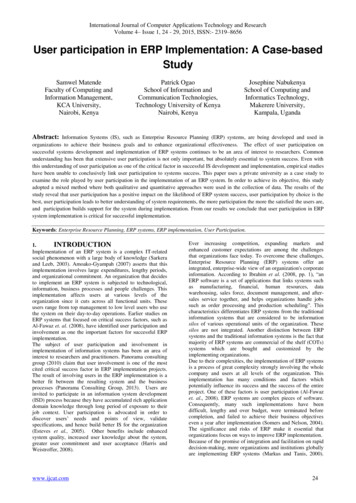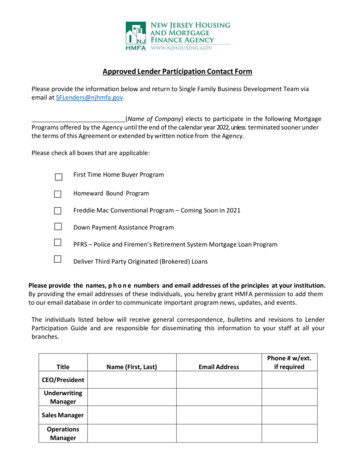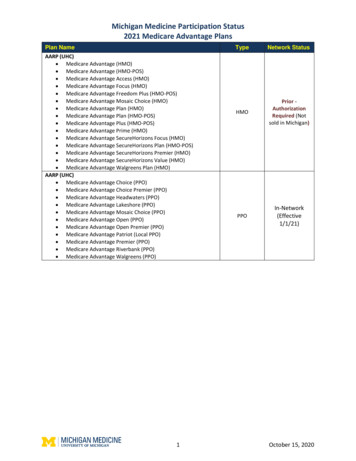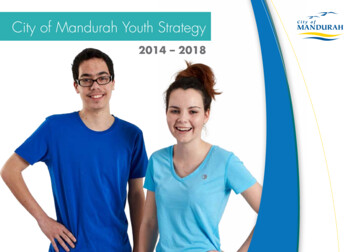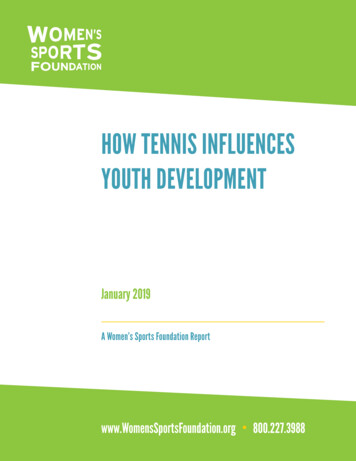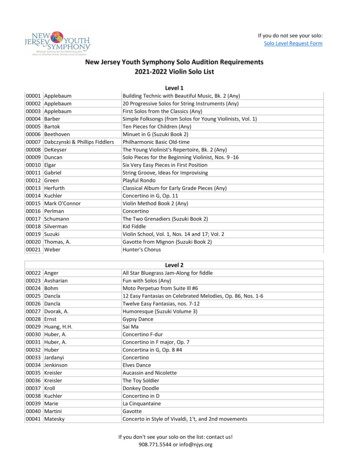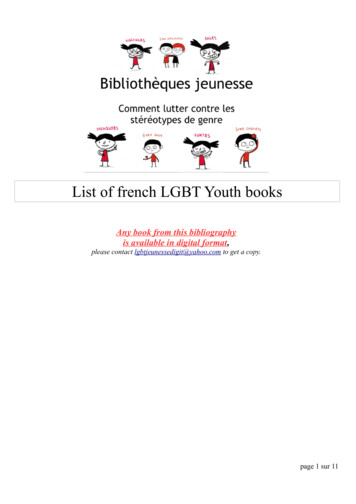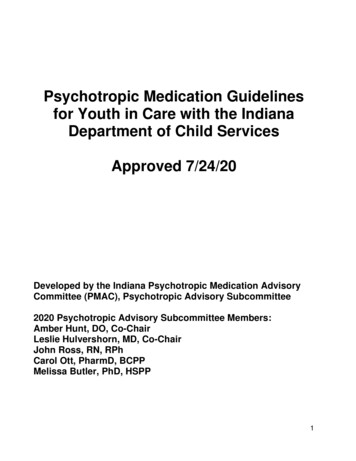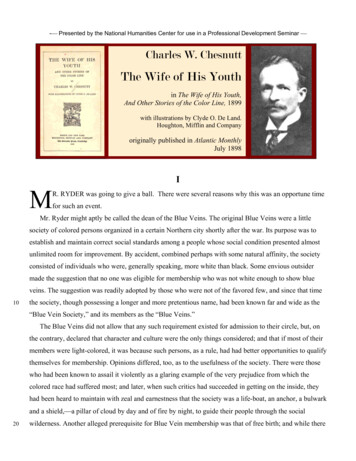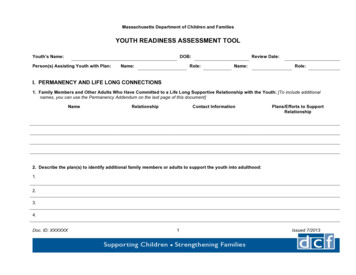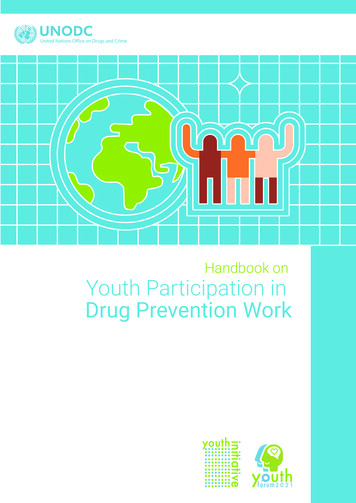
Transcription
Handbook onYouth Participation inDrug Prevention Work
Cover illustration credits: Yara Hindawi, UNODC 2020
Handbook on Youth Participationin Drug Prevention Work
ForewordThe United Nations Office on Drugs and Crime is deeply committed to providing high quality and comprehensivesupport to all persons around the world working to prevent substance use and substance use disorders.Developing healthy, involved and committed young persons with a zest for life contributes to a more positiveenvironment for all. Youth should not solely be the “receiver” of drug prevention efforts but should be activeparticipants and determinants in their own future.This Handbook on Youth Participation in Drug Prevention Work is developed to provide informed guidanceto policy makers and other community leaders seeking to implement a comprehensive prevention system thatincludes meaningful youth participation at all levels.In an effort to model the process we are advocating for, UNODC has developed this Handbook with significantcontributions from youth as you can clearly see as you review the material contained within.I am convinced that creating meaningful places for youth to be engaged, empowered and participate in the development of, implementation of and evaluation of substance use prevention efforts, strengthens not only the preventionsystem but the youth themselves. Thus, I invite policy makers to consider strengthening the role that youth playin developing and implementing the substance use prevention programs that impact them and their peers.Gilberto Gerra, ChiefDrug Prevention and Health BranchPrevention, Treatment and Rehabilitation SectionUnited Nations Office on Drugs and Crime United Nations Office on Drugs and Crime, October 2020. All right reserved.General disclamers.The designations employed and the presentation of the material in this publication do not imply the expressionof any opinion whatsoever on the part of the Secretariat of the United Nations concerning the legal status of anycountry, territory, city or area, or of its authorities, or concerning the delimitation of its frontiers or boundaries.The mention of specific companies or of certain manufacturers’ products does not imply that they endorsed orrecommended by UNODC in preference to others of a similar nature that are not mentioned. Errors and omissionsexcepted, the names of proprietary products are distinguished by initial capital letters. All reasonable precautionshave been taken by UNODC to verify the information contained in this publication. However, the publishedmaterial is being distributed without warranty of any kind, either expressed or implied. The responsibility for theinterpretation and use of the material lies with the reader.In no event shall UNODC be liable from damages arising from its use.3
AcknowledgementsThe United Nations Office on Drugs and Crime, wishes to acknowledge the contributions of all the youth, experts,policy makers, civil society partners and staff members that participated in the development of the Handbook onYouth Participation in Drug Prevention Work.We extend Special appreciation is extended to the youth leaders who tirelessly and willingly contributed theirknowledge, experience and time to increase opportunities for youth to participate around the world. UNODCequally extends appreciation to the UNODC staff and technical consultants that actively contributed to thedevelopment of this document – Ms. Giovanna Campello, Ms. Elizabeth Mattfeld, Ms. Asma Fakhri, Ms. HeeYoung Park, Ms. Stefanie Schmatz, Ms. Hanna Heikkilä, Ms. Yara Hindawi, Ms. Iris Hoffmann, Ms. FranciscahKosgey, and Ms. Nina Fabiola Montero Salas.Expert Group Participants: Dr. Nicole Eisenberg, Ms. Nadia Gasbarrini; Prof. Gerardo Javier Melendez-Torres,Prof. Carmen Orte, Mr. Kassym Sarsenbayev, Dr. Jeremy Segrott, and Ms. Hanna Heikkilä.Youth Forum Participants: Abbas I. Babayev, Ann-Dean Cooper, Anna Mitrofanova, Anna Shenia Hauptmann,Asedria Simoes Ruck, Bat-Anujin Tumurkhuyag, Chethmi Wijewardana, Christopher Misael Agreda Díaz, CurtisMark, Desislava Pehlivanova, Egorov Kirill, Erkin Özgür, Haitham Ajjeh, Hasting Blowdy, Heather d’Alessio,Henna Siiki, Ivana Todorova, Javier Andrés Chinchilla Padilla, Javier Ng Jing Xuan, Joanne Lunkuse, Juan DavidSEFAIR MELO, Katarína Saparová, Khalid Shaya M. ALQAHTANI, Lisa Holmås, Lucija Blazan, MahathirShamsuddin, Matúš Marec, Maximilian Granser, Megan Cungu, Merve Yetistirici, Michael Schädler, NicolasMarxer, Nidal Oudainia, Pimenova Alexandra Igorevna, Sagar Singh Grewal, Valeryja Polyakova, WAN Xinyang,WANG Zixiao, Xinyang Wan, Yana Zakharyants, Yomna Ahmed Abdel Fattah El Dib, Zeno Roscam Abbing,and Zixiao Wang.Finally, UNODC would like to thank the Government of the Russian Federation for supporting this initiative,as well as the Government of South Korea for providing supplementary resources.45
ContentsForeword. 3Acknowledgements. 4Handbook on Youth Participation in Drug Prevention Work. 7I. Introduction. 7II. Definitions. 8III. United Nations commitment to both prevention and youth participation. 9IV. What is prevention?. 10Settings, ages and stages in prevention. 12V. What is participation?. 12A. Different levels and dimensions of participation. 12B. Value of participation in prevention. 14C. How to enable successful youth participation across different levels and dimensions. 16D. Match the level of participation to the available resources and organizational readiness. 16E. Communicate expectations and possibilities transparently. 17F. Make youth participation accessible, safe and relevant. 17G. Select youth purposefully. 18H. Youth participation in the different stages of prevention programming and policymaking. 191.Identify the issue: data collection and analysis for identifying needs and possibilities. 202. Initiate a plan based on evidence of what works. 203. Implement the strategy, plan or activities. 214. Monitor and evaluate the results of the activities. 22I. Youth participation in different prevention settings. 241. Schools. 242. Family. 253. Media and online environments. 254. Youth voices in political processes, governmental structures and public discussions. 265. Communities and prevention systems as a whole. 27VI. Conclusion: enabling and encouraging youth participation in substance use prevention. 28Annex I. 30Annex II. 31Don’t. 31References. 32Handbook on Youth Participationin Drug Prevention WorkI. IntroductionThe goal of the present handbook is to offer encouragement, examples, rationales and concrete advice on how to increaseyouth participation in substance use prevention, harnessing the insights of young people on the most important targetgroup in prevention efforts: their peers. It is designed to enable all decision makers to capitalize on the power of youthparticipation, exploring the full potential of young people as a force for change. The guidance is aimed at leaders incharge of substance use prevention and health promotion efforts at the local, regional, national and international levels.The handbook provides an overview of youth participation and what role it might play in prevention. It seeks to convey the value of evidence-based prevention in building healthy and prosperouscommunities and societies, and the value of young people as important contributors to preventionefforts. By so doing, it seeks to contribute to the normalization of youth participation in prevention.One of its key objectives is to unravel the misconception that young people have limited capabilities tocontribute to substance use prevention efforts. In addition to dismantling such misconceptions, whichcan lead to the hesitation to include youth in such efforts, it also seeks to raise caution against the possibleundesired outcomes of involving youth merely for the sake of visibility and thereby contributing to an environment of tokenism. Finally, it also seeks to address the misconception that merely being a young personand interested in being involved in substance use prevention is sufficient to achieve prevention outcomes.In this handbook, it is stressed that achieving purposeful, ethical youth participation requires education forall parties involved, not only on evidence-based prevention, but also on youth participation itself. Decisionmakers and professionals deserve capacity-building on how to generate meaningful participation among youngpeople. Similarly, researchers could benefit from support and training on how to carry out research both withand for young people. It is equally important to ensure the education, training and development of the participating youth. Only sufficient guidance and other organizational support will enable young people to playa meaningful role in the process. Well-informed and well-trained policymakers, leaders and youth are a keycomponent in ethically planning, implementing and evaluating effective substance use prevention interventions.There is existing research and guidance on involving youth in political structures or work related to health and socialcare aimed at supporting positive youth development (see, for example, South Australian Government, 2016; Department of Economic and Social Affairs, 1996; Project Y.A.D., n.d.; Catalano and others, 2019). However, researchspecifically examining substance use prevention efforts in which youth play an active and meaningful role is muchscarcer. This handbook is aimed at opening that discussion and providing a basis for future research efforts. The handbook is based on an overview of the scientific literature and related database search results and is grounded in real-lifecase studies shared by participants in the United Nations Office on Drugs and Crime (UNODC) Youth Initiativeand guidance offered by a globally representative expert group assembled during the development of the handbook.The call to develop guidance on youth participation in drug prevention work was initially raised by youthparticipating in the UNODC Youth Forum in 2018. The Youth Forum annually gathers young people active insubstance use prevention efforts in their communities to exchange views and experiences, learn from each otherand from experts, and present their views on substance use prevention to the representatives from around theworld participating in the sessions of the Commission on Narcotic Drugs, those leaders making policy decisionsrelating to the global action to address the world drug problem. It is hoped that the handbook will help to createopportunities for yet more young people to contribute to substance use prevention efforts in their communitiesand societies, as well as at the global policy level.67
Figure 1Intersections of meaningful youth engagement in preventionMeaningfulengagement ofyouth insubstance usepreventionEffective prevention exists in the context of health-centred substance use policies that encompassboth demand and supply reduction, and, within the domain of demand reduction, that address treatment, as well as the prevention of the health and social consequences of substance use. Moreover, effective substance use prevention addresses the predictors or root causes of substance use, often many yearsbefore the youth would be likely to engage in substance-using behaviours. Effective prevention reducesthe risk factors that increase the probability of engaging in drug use and strengthens t
This Handbook on Youth Participation in Drug Prevention Work is developed to provide informed guidance to policy makers and other community leaders seeking to implement a comprehensive prevention system that includes meaningful youth participation at all levels. In an effort to model the process we are advocating for, UNODC has developed this Handbook with significant contributions
